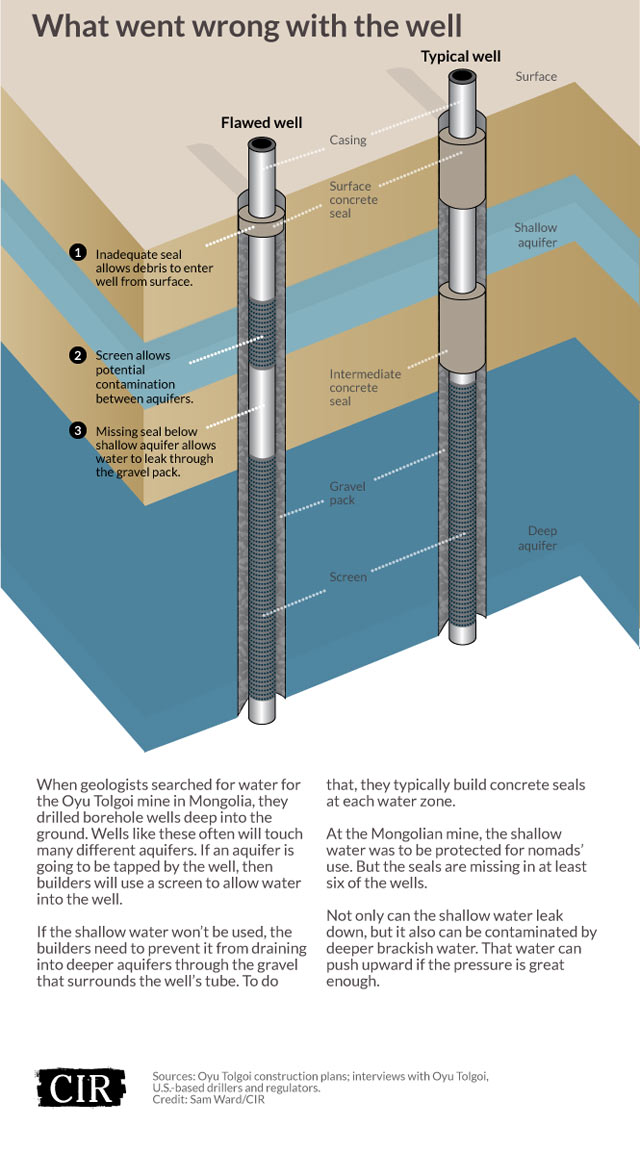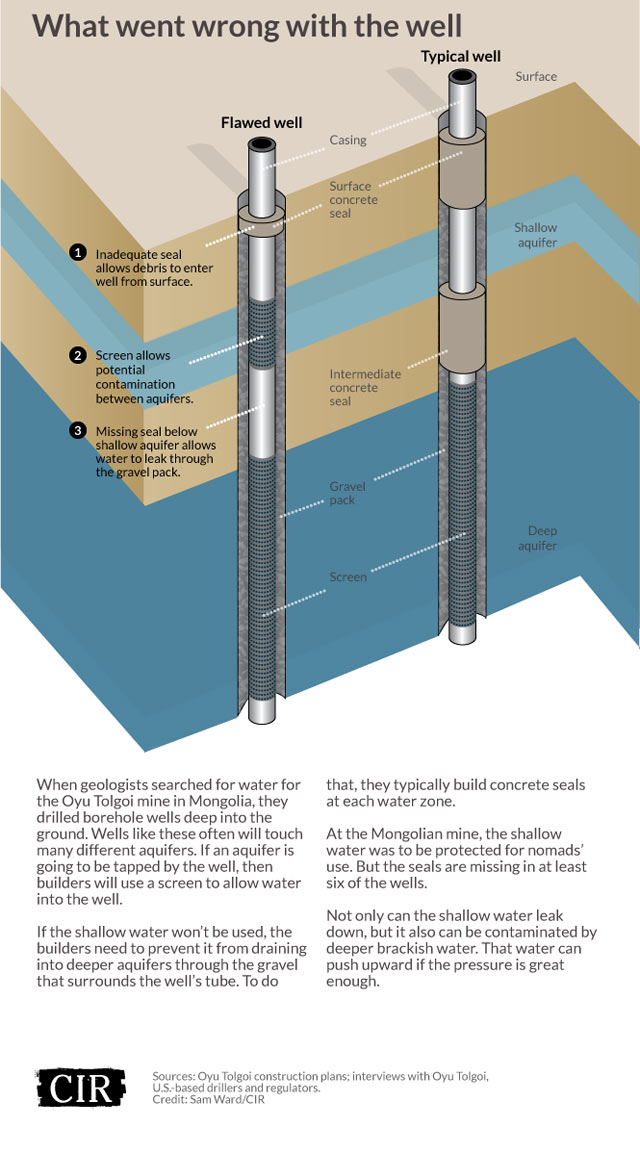Khanbogd, Mongolia – Ichinkhorloo Buya scooped fresh water into the camels’ trough and waited for them to return. The whooshing water always beckoned the animals, with their sharp sense of hearing, home.
But this time, they were nowhere to be found. Her children raced off across the bumpy moonscape of the Gobi Desert on motorbikes in a frantic search. They eventually found the camels huddled around an old rusty well. There was no reason the camels should congregate there.
But they heard something the men didn’t – an underground flow of fresh, cold water.
That sound meant something had gone awfully wrong: The precious underground water that sustains the herders’ fragile existence was flowing down into the brackish aquifer controlled by a booming copper and gold mine that’s rapidly changing daily life in Mongolia’s Gobi Desert.
This land of nomads boasts one of the world’s fastest-growing economies, thanks in part to that massive Oyu Tolgoi mine. It alone is expected to account for up to one-third of the country’s gross domestic product and deliver much-needed infrastructure and good jobs.
But as the mine scales up, the operation that’s now led by mining giant Rio Tinto has struggled to live up to its promises of world-class environmental standards. The mine pledged, for example, to leave herders’ scarce water sources untouched.
While company officials say the problems haven’t had a major impact on locals’ water, herders say that since the company built the wells, the land and their own wells have gotten drier.
Brian White, a senior adviser at Oyu Tolgoi, said the company continues to strive to meet or exceed both Mongolian and international standards.
“We have demonstrated progression toward meeting the commitments we have set,” he said in an email.
The mine has put itself directly at odds with a traditional way of life that’s already facing the strains of drought and climate change. Mongolia has warmed more than any other country in the last century, nearly 4 degrees Fahrenheit in 70 years.
Grazing land is disappearing. Wells are drying up. Plants that survived years of drought now are withering. Herds of camels are dying. The changes have altered basic life here, sparking an exodus of traditional herders from the dry, dusty plains to the shantytowns of the capital city, Ulan Bator.
“I would say this is the beginning of a disaster,” said Ravdaudorj Khayandorj, a south Gobi herder near the mine. “Not many people are left. They’re all fleeing to the north.”
About a quarter of the country’s nearly 3 million people live at the edges of the capital in yurts they brought with them from the increasingly uninhabitable countryside. The former herders have no running water or sewage system. But they do have a view. On days when the air isn’t choked with coal smoke, they watch tract housing and office space spring up amid the last generation’s severe Soviet housing blocs. They count the cranes on the horizon. They hope for construction work.
Growing Demand For Copper
Before it was a thriving mine, Oyu Tolgoi was little more than a hill in the vast desert.
Bits of green copper glinted in exposed rock, and the herds of nearly a dozen nomadic families grazed on grass and drank from a natural spring. The families relied on the milk, meat and hair of the camel to scratch out a living.
More than a decade ago, geologists realized the mineral deposits could be worth billions. One investment firm valued them at $300 billion. But to get the metals, a mining company would need massive amounts of water.
Neighboring China’s booming construction industry has fueled the demand for copper, in particular, which is used in everything from electrical wiring to plumbing and telecommunications. It’s also a key component in green energy products like hybrid cars and solar panels.
Water is not easy to come by in the Gobi. With as little as 2 inches of rain a year, an ephemeral river and hand-dug wells, the nomads couldn’t afford to share their water.
The mining company needed to find its own water. For that, it drilled exploration wells hundreds of meters deep.
The company had to build wells carefully to ensure the shallow water, so vital to the herders and already in short supply, would be protected. To get rights to the water it hoped to discover, the company in charge of the mine promised to uphold international environmental policies and first-rate development standards.
For example, in order to get financing from the European Bank for Reconstruction and Development, the company pledged to abide by the lender’s policies. One of its water standards includes demonstrating that the mine’s water supply wouldn’t have a negative impact on the water upon which locals depend.
In 2003, hydrogeologists made the discovery that made the mine possible – a perfect aquifer named Gunii Hooloi. It was far too deep for locals to access and too salty to be drinkable even if they could.
By 2009, Rio Tinto was about to take control of Oyu Tolgoi. Before it did, though, it needed to sign an investment agreement with the Mongolian government. Facing a $6 billion price tag to build the mine, investors wanted assurances that regulations and taxes would remain stable.
Negotiations, which had been going on for years, were just months away from concluding when word first surfaced of the leaking water in the desert. Oyu Tolgoi made no public statements on the wells. Several nomads said Oyu Tolgoi told them everything was fine. The government and Rio Tinto signed the agreement in October 2009.
Then in 2010, Oyu Tolgoi was preparing for a press event to show off its facilities. A local leader and chemical engineer named Danzanshadov Enkhsaikhan emailed the company. He threatened to bring reporters to hear the water cascading down the well shaft.
The response he got included an internal note, suggesting the company was as concerned about bad press as it was about water supplies.
In a note to staff, Samand Sanjdorj, Oyu Tolgoi’s vice president, proposed plugging the wells with concrete. It wouldn’t stop the cascading completely, but it would curtail the leakage significantly, he wrote.
Plus, “at least no one will hear that some water is leaking down with a noise,” Sanjdorj wrote. “I can imagine that if the press media comes to the bore and hear the cascading noise we will be in very bad situation.”
Improperly Built Wells
An hour’s drive from the small village that’s the herders’ central meeting place, a rusty tube sticks out of the desert’s sandy dirt. Nearby, a taller rusty pipe with a concrete base keeps watch like a miniature lighthouse.
Every nomad in these parts seems to know how to find these little tubes. Nomads have masterful orientation skills. They use the trajectory of the sun and the mountains in the distance to navigate a landscape with few visible roads and no landmarks other than clumps of brittle brush every few feet.
The tubes became a famous point of interest once word spread that the wells were making noise.
On a scorching hot day in July, Enkhsaikhan knelt down next to the tube. It wasn’t making any noise. But that wasn’t a good sign, he said. It suggested the shallow water the herders rely on was gone.
The tube touches several aquifers at different levels as it descends hundreds of meters into the sandstone and clay.
When companies build exploration wells that touch different water sources, like those outside Oyu Tolgoi, they must be sealed with impermeable material. This ensures water from a shallower source cannot cascade into a deeper one.
The contractor didn’t build those seals at Oyu Tolgoi’s wells. The construction plan shows only gravel where an impermeable barrier should be.
A “technological mistake,” Oyu Tolgoi’s vice president called it.

At least five other wells were cascading, too, a specialist brought in by the government later confirmed. Rio Tinto blames its drilling contractor, RPS Aquaterra, saying the company constructed the wells incorrectly.
But Rio Tinto should have been able to adequately oversee the work of its contractors, said mining expert Paul Robinson of the Southwest Research and Information Center, a New Mexico-based nonprofit focused on natural resource protection.
“What they did completely defeats the purpose of what was committed to and agreed to,” he said. “It is really bad performance.”
Bruce Harvey, a consultant for Rio Tinto, said the water loss is minimal. He compared it to “the width of the hair on your head compared to the size of this room,” during an interview in a mine classroom that would fit about 40 people in desks.
There are no public scientific studies or data that show how much water was lost.
White pointed to a company report that says the cascading does not have a “measurable impact” on the shallow aquifers upon which the herders rely.
Even so, the shallow and deep aquifers now appear to be connected, according to an independent 2013 audit. That can cause the contamination of the freshwater aquifer if the cascade reverses, a problem that’s potentially as serious as water loss.
Herders like Khayandorj said that since the exploration wells went in, plants that had survived years of drought have died.
“Yes, there were two to three years of severe drought,” he said, sitting in his yurt over bowls of salty milk tea. “But right after they set up those wells, families had to move away because of changes in the grass.”
Two wells he once used now are dry. He told Oyu Tolgoi, which has promised to find a new water source for any herder with a dry well. The company has dug several new, deeper wells for other herders. But in his case, the efforts didn’t work.
“They came. They dug with their machinery,” he said. “Nothing. It’s dry.”
Khayandorj and his family spent the entire summer, usually a time of rest for nomads, setting up temporary camp, constantly on the move for sufficient grass and water for their herds.
The nomads have suffered other affronts during Rio Tinto’s mine development. The company replaced a natural spring that was a place of worship with what looks like a man-made drainage ditch. It also dug up sacred elm trees, according to the US Agency for International Development.
Lkhamdoorov Battsengel’s family, along with 10 others, used to live and graze their herds on pastureland of the Turquoise Hill, as the area is known. His family alone had 600 sheep and goats, 100 camels and dozens of horses and cows. When the mining company fenced in its land, it forced the families to relocate.
The land where Battsengel resettled couldn’t sustain his herds. He is down to 100 animals in total.
He’s now started a nonprofit environmental organization called Gobi Soil to influence Oyu Tolgoi’s environmental policies. It has banded with bigger nonprofits to file formal complaints with the International Finance Corporation, which is considering a $1.4 billion financing package to develop the mine further.
“We still have time to turn things back,” he said.
Battsengel now supports his family by collecting trash for Oyu Tolgoi.
Join us in defending the truth before it’s too late
The future of independent journalism is uncertain, and the consequences of losing it are too grave to ignore. To ensure Truthout remains safe, strong, and free, we need to raise $46,000 in the next 7 days. Every dollar raised goes directly toward the costs of producing news you can trust.
Please give what you can — because by supporting us with a tax-deductible donation, you’re not just preserving a source of news, you’re helping to safeguard what’s left of our democracy.
